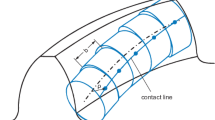Abstract
Gear lapping is a highly productive method of hard finishing hypoid gears for appliances with high demands regarding transmission noise. The absence of a solid tool, however, makes the prediction of the resulting topology difficult. Thus, the design of a lapping program resulting in a desirable topology is a matter of personal experience and empirical efforts.
In this paper, a simulation of the local surface wear produced by lapping bevel and hypoid gears is extended to incorporate the influence of the abrasive particles on the local distribution of flank pressure and wear depth. High-resolution experimental investigations of lapped tooth flanks are used to validate the accuracy of the current simulation method and deduce possible improvements. Finally, two methods to integrate the simulation in a production-driven gear design process are proposed.
Zusammenfassung
Das Läppen von Kegel- und Hypoidverzahnungen stellt ein hochproduktives Verfahren zur Hartfeinbearbeitung dar. Es wird insbesondere bei hohen Ansprüchen an das Lauf- und Geräuschverhalten eingesetzt, wie sie beispielsweise die Automobilindustrie stellt. Das spanende Verfahren mit losem Korn und daher unbestimmter Schneidbahn erschwert jedoch die Vorhersage der resultierenden Mikrogeometrie. Die Erstellung von Läppprogrammen ist daher bislang geprägt von Versuchen und der persönlichen Erfahrung einzelner Mitarbeiter.
Beim Verzahnungsläppen haben die im Zahnkontakt befindlichen abrasiven Partikel einen wesentlichen Einfluss auf die Lastverteilung der kontaktierenden Flanken und damit auf die im Läppprozess erzielte Abtragsverteilung. In diesem Beitrag wird eine Simulation des lokalen Läppabtrags um diesen Einfluss erweitert. Hochauflösende taktile Abtragsmessungen dienen zur Untersuchung der relevanten Einflussgrößen und der Validierung der Simulation. Darüber hinaus werden zwei mögliche Wege zur Anwendung einer Läppsimulation innerhalb des Auslegungsprozesses von Kegelradverzahnungen vorgeschlagen.







Similar content being viewed by others
References
Rudolph F, Schumann S, Schlecht B (2017) Experimental studies and simulation of hypoid gear lapping. Forsch Ingenieurwes 81(2). https://doi.org/10.1007/s10010-017-0214-4
Jiang Q, Gosselin C, Masseth J (2008) Simulation of Hypoid Gear Lapping. J Mech Des 130(11):112601. https://doi.org/10.1115/1.2976453
Park D (2009) Development of surface wear and lapping simulation models for hypoid gears. Dissertation, Ohio State University
Wagner W, Schumann S, Schlecht B (2018) FVA 777 III – Durchgängigkeit lokale Berechnungsverfahren. Forschungsvereinigung Antriebstechnik e.V., Frankfurt/Main
Schaefer S (2018) Verformungen und Spannungen von Kegelradverzahnungen effizient berechnet. Dissertation, Technische Universität Dresden
Archard JF (1953) Contact and Rubbing of Flat Surfaces. J Appl Phys. https://doi.org/10.1063/1.1721448
Meng HC, Ludema KC (1995) Wear models and predictive equations: their form and content. Wear 181–183:443–457
Williams JA (1999) Wear modelling: analytical, computational and mapping: a continuum mechanics approach. Wear 225–229:1–17. https://doi.org/10.1016/S0043-1648
Andersson S (2010) Wear Simulation. In: Fuerstner I (ed) Advanced Knowledge Application in Practice
Klingelnberg J (ed) (2016) Bevel Gear. Fundamentals and Applications. Springer, Berlin, Heidelberg
Schlecht B (2010) Maschinenelemente. Pearson, München
Rabinowicz E, Dunn LA, Russell PG (1961) A study of abrasive wear under three-body conditions. Wear 4(5):345–355
Adachi K, Hutchings IM (2003) Wear-mode mapping for the micro-scale abrasion test. Wear 255(1–6):23–29
Nelder JA, Mead R (1965) A Simplex Method for Function Minimization. Comput J 7(4):308–313. https://doi.org/10.1093/comjnl/7.4.308
Acknowledgements
The authors would like to thank BMW Group and Klingelnberg GmbH for funding the work on which this paper is based.
Author information
Authors and Affiliations
Corresponding author
Additional information
The program BECAL, which is a basis of this article, is a program of the Forschungsvereinigung Antriebstechnik (Drive Technology Association) FVA (http://fva-net.de). It was developed by the Institute of Machine Elements and Machine Design in cooperation with the Institute of Geometry of the TU Dresden on behalf of the FVA.
Rights and permissions
About this article
Cite this article
Rudolph, F., Schumann, S. & Schlecht, B. Consideration of solid particles in a gear lapping simulation. Forsch Ingenieurwes 83, 801–808 (2019). https://doi.org/10.1007/s10010-019-00342-9
Received:
Revised:
Accepted:
Published:
Issue Date:
DOI: https://doi.org/10.1007/s10010-019-00342-9




